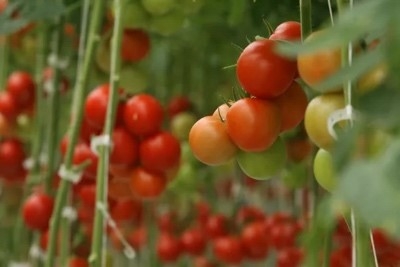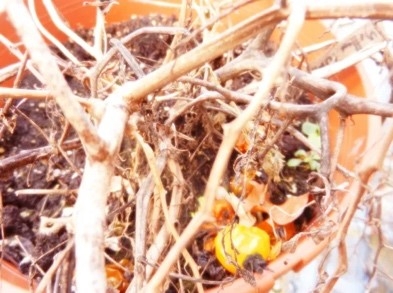Microbes: Their Role Creating a Productive Garden
This year, did you decide that you were going to start a garden in your backyard and start growing your own vegetables rather than buying them from the store? You thought you would get something like this:
But instead, you ended up with something like this:
Well, maybe it wasn't that bad, but you know what I am getting at. You bought all the all the things that you thought you would need. You dug out all the grass and old plants. You rototilled the ground well, removing rocks and old roots and breaking up any large clumps of soil. The ground looks great and ready to plant! You consulted with the experts at the store, selected the best quality seeds, and carefully chose the best starter plants. You made sure to add the right amount of fertilizer and water as needed. And you put in a lot of hard work. So, what happened?
Did you ever stop to think about the soil in which you planted those seeds and starter plants? You took the time to think about the living plants you wanted to raise in your garden, but did you consider that soil is not a lifeless growing medium but is home to billions of bacteria, fungi, and other microbes? These organisms can have a beneficial partnership with the plants in your garden. Their existence, or lack thereof, can add or detract from your garden's productivity.
Although we may often tend to think of microorganism as nasty little bugs that we can't see and need to get rid of, we are currently discovering more and more about the important role that they play in not only the soil but in our bodies as well. Your garden soil consists of a complex network of interactions and relationships between various organisms that live in it. We often refer to this network as the “Soil Food Web.” The diagram below shows the interconnected food chains and energy flow within the soil ecosystem.
The soil food web is made up of five trophic levels that indicates an organism's position in the food chain, its energy source, and role in transferring energy within the ecosystem. Each trophic level differs in how it transfers energy and cycles nutrients. The soil food web begins with the energy from the sun, which triggers photosynthesis in plants. ?The process of photosynthesis takes carbon dioxide and converts it to carbon and organic compounds. ?The first trophic level consists of plants and their organic material. ? Simple soil organisms that decompose plant material, including bacteria and fungi are found in the second trophic level. Larger soil organisms are found in the third trophic level. It includes organisms such as protozoa, nematodes, and arthropods that feed on the second-level organisms. ?Finally, the fourth and fifth trophic levels consist of higher-level predators feeding smaller soil organisms. ?
In many ways, the soil food web plays a crucial role in the health of the soil in your garden.
The bacteria, fungi, and other microbes found in the second trophic level of the soil food web form symbiotic relationships with plants and other organisms. Soil microbes have been shown to reduce the incidence of plant diseases through competing with pathogens for resources, producing antimicrobial compounds, or inducing systemic resistance in plants. The activities of microbes in the soil can assist in the formation of soil aggregates that improves soil structure and enhancing water retention, aeration, and the root penetration necessary for healthy plant growth. Finally, microbes provide essential decomposition of organic materials releasing nutrients like nitrogen, phosphorus, and potassium available for plants through the process of nutrient cycling.
Soil microbes play an important role in the soil food web, soil health, and the creation of a productive garden. They form symbiotic relationships with plants, break down organic matter to release nutrients into the soil to be used by plants, and much more. In future articles for this blog, I will further explore ways that you can better understand and manage the microbes in your garden, rather than seeking to eliminate them. Stay tuned and enjoy your garden.
Reference:
Clutter, C., (2021, May 13). Unearthing the Soil Microbiome, Climate Change, Carbon Storage Nexus.
American Society for Microbiology. https://asm.org/articles/2021/may/unearthing-the-soil-microbiome,-climate-change,-ca
Learn about Soil Types. (n.d.). National Environmental Satellite, Data, and Information Service. https://www.nesdis.noaa.gov/learn-about-soil-types#
Rash, W., (2022, April 21). Boosting Soil Health in Your Garden. USDA – NRCS California
National Resources Conservation Service. (n.d.). USDA-NRCS Official Soil Series Description View by list. https://soilseries.sc.egov.usda.gov/#
Natural Resources Conservation Service. (2024, May 21). Natural Resources Conservation
Service. https://www.nrcs.usda.gov/conservation-basics/natural-resource-concerns/soils/soil-health
Sundermeier, A., Shedekar, V., & The Ohio State University. (n.d.). HEALTHY SOIL HEALTHY ENVIRONMENT. Soil Biology Primer. https://soilhealth.osu.edu/sites/soilhealth/files/imce/WhitePapers/The%20Soil%20Food%20Web.pdf
USDA Sustainable Agriculture Research and Extension. (2024, January 26). Building soils for better crops - SARE. SARE. https://www.sare.org/resources/building-soils-for-better-crops/
Walsh, S., (2004, Winter). The Basis for a Healthy Garden. University of California, Agriculture and
Natural Resources. https://ucanr.edu/sites/mgslo/newsletters/Soil_-_The_Basis_for_a_Healthy_Garden28260.htm#
White, C. (n.d.). Managing soil Health: Concepts and Practices. https://extension.psu.edu/managing-soil-health-
concepts-and-practices





